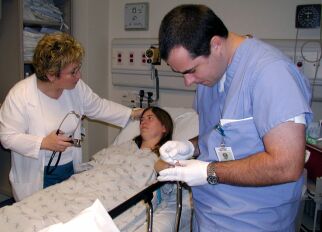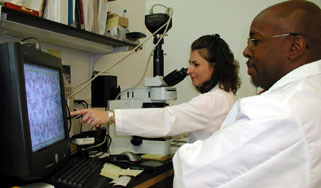 |
Although eliminated from the United States in 1951, malaria can still affect U.S. residents who travel or work abroad. On average 1,200 cases and 13 deaths are reported in the United States each year. Nearly all of these deaths are preventable.
|
|
 Patient receives medical attention for malaria. (CDC photo) Patient receives medical attention for malaria. (CDC photo) |
 |
CDC's Role in Prevention and Control of Malaria in the United States
 |
 |
 |
 |
CDC's treatment guidelines featured in this JAMA issue devoted to malaria.
(Courtesy JAMA)
|
 |
 |
In addition to monitoring the number of cases of “imported” malaria, CDC provides clinical advice to health-care professionals and recommendations for travelers to malaria-risk areas. Recently, CDC has updated the standard CDC malaria diagnosis and treatment guidelines, which were published in an article in JAMA May 23rd and can be accessed for free online: view JAMA article.
The Updated Guidelines
This article represents the most comprehensive review of malaria treatment in the United States in the last 10 years.
It captures the evidence base for recognition and diagnosis of malaria; treatment of severe and uncomplicated malaria; special situations, for example, malaria in children and pregnant women; induced malaria; and malaria self-treatment.
The article discusses how best to
- properly diagnose a malaria infection
- identify various clinical conditions and
- provide specific treatments
- care for certain groups, like children or pregnant women
It also contains a comprehensive table on antimalarial drugs recommended for treatment as well as a malaria treatment algorithm to assist health-care providers in their diagnosis and treatment of suspected or confirmed cases.
Other Resources for Health-Care Providers
 |
 |
Stephanie Johnston and Henry Bishop of CDC’s Division of Parasitic Diseases discuss telediagnosis images received through the Internet. (CDC photo)
|
 |
 |
Malaria is a medical emergency that requires immediate diagnosis and treatment. Clinicians seeking assistance with the diagnosis or treatment of patients with suspected or confirmed malaria can call the CDC Malaria Hot Line at 770-488-7788 during regular business hours, or the CDC Emergency Operations Center at 770-488-7100 during evenings, weekends, and holidays.
CDC also offers telediagnosis to better assist laboratory workers in diagnosis of malaria and other parasitic diseases. When U.S. and international laboratories are not sure about what they see when searching for malaria parasites on a slide, they can e-mail images of the suspected parasites to dpdx@cdc.gov.
How Can Malaria Be Prevented?
If you are traveling to malaria risk areas you should:
 |
 |
 |
 |
This picture shows some things that travelers can use to protect themselves against malaria: malaria pills; insect repellent; long-sleeved clothing; bednet; and flying insect spray.(Not shown, but also protective: air conditioned or screened quarters.)
(CDC Photo)
|
 |
 |
- Visit your health-care provider 4–6 weeks before travel and obtain a prescription for an antimalarial drug that is appropriate for your particular destination. All of these medicines must be taken for a certain amount of time before travel, during travel, and after departing from the malaria risk area.
- Apply insect repellent to prevent mosquito bites if you will be out of doors between dusk and dawn when the mosquito that transmits malaria is biting. Your insect repellent should contain DEET as its active ingredient.
- Wear long pants and long-sleeved clothing.
- Consider applying permethrin (often found in stores with the camping equipment) to the clothing that you will be wearing during travel as an additional layer of mosquito prevention.
- Sleep under an insecticide-treated bed net, especially if you are not staying in screened or air-conditioned housing.
Page last modified : May 24, 2007
Content source: Division of Parasitic Diseases
National Center for Zoonotic, Vector-Borne, and Enteric Diseases (ZVED)
|
 |
|






